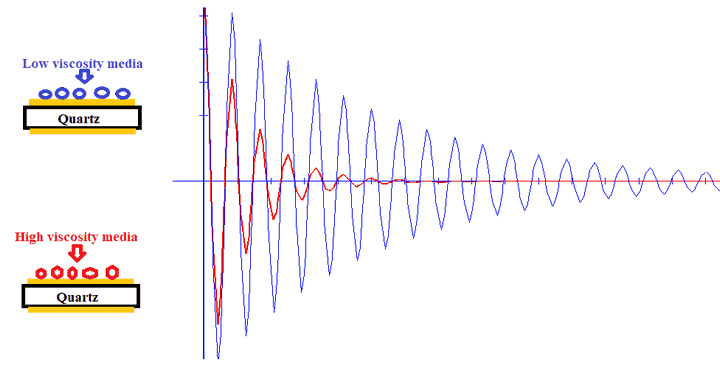Quartz crystal is a very thin oscillator that can provide stable frequency under certain conditions. In electronics, quartz crystals are widely used to provide steady and constant frequencies. However, crystal resonance properties are affected by environmental properties such as temperature or quartz plate mass. If, in electronics, this might be undesired effects, it becomes a valuable tool for biosensor applications in other areas such as nanotechnology, biology, and biomedicine. The changes in the crystal sensor frequency due to mass changes can be used to detect the properties of the environment. The method is the so-called Quartz Crystal Microbalance with Dissipation measurements or simply QCMD.
The working principle of QCMD
Gravimetric Regime
The idea of Quartz Crystal Microbalance with Dissipation measurement is relatively straightforward – a thin film of the liquid matter is applied onto the surface of the crystal resonator. The matter slightly changes the frequency properties of the resonator. By measuring the frequency change and amplitude dissipation, much interesting information can be gathered from measured films, such as mass and viscosity/viscoelasticity. Such a sensor is susceptible to small changes in mass and properties of the measured film in liquid media.

Non-Gravimetric Regime
In a non-gravimetric regime, the gravity factor is excluded, which allows for measuring other hydrodynamic effects of solvents. Measurement results highly depend on the shape of the sensor and solvent organization. This allows for measuring the forms of biological or nanostructures in solvents such as DNA mutations or other contaminants. This method opens the excellent potential for diagnostics and taking liquid biopsies in medicine.
Typical applications of QCMD sensors
There can be endless applications of such sensors because the same principle can be applied to many areas where small and nanoscale measurements are required, but probably the most promising is biosensing. Successful trials show that liquid biopsies are possible to detect cancerous DNA mutations. In most cases, a biopsy of tissue is taken to identify cancer, and this procedure can be painful and biased to a single operation. After surgery, there is no accessible tissue to be biopsied when the tumor is removed. In such cases, liquid biopsies are a great non-invasive way of biomarker analysis.
Liquid biopsy analysis allows early detection of such cancers as lung, colorectal, prostate, breast, and others. Using QCMD sensors, it is possible to track tumor dynamics in real-time and adjust the treatment according to live results. Many projects indicate a successful set of applications of using piezo acoustic sensors. Emerging High-Frequency Crystal Microbalance technique with much thinner plates and high frequencies reaching more than 100Mhz promise even more heightened sensitivity to mass changes on the probe surface. A smaller sensor requires less sample DNA allowing specific targeting and detection of circulating tumor DNA.
For instance, by implementing colorectal cancer sensing using a liquid biopsy technique with QCMD sensors, the reliability reaches 95 – 100% while reducing the cost to 50€ per sample. Also, the analysis time is significantly reduced up to 30min. This is a leap from biopsies, which is still a gold standard but still a slow, expensive, and one-time shot method.
Other applications that benefit from QCMD sensor technology are the food industry, where you can test product properties. For instance, honey adulteration control, finding residues such as pesticides in honey. See more research and applications on the projects page.
Conclusion
QCMD sensor technology is not very new and is already being used in many applications starting in the electronics, the food industry, and biosensing. However, the modern approach allows the manufacturing of more sophisticated smaller, more precise sensors and have a much higher base operating frequency. They open new areas of biosensing of DNA and other properties of biological liquids. High accuracy, fast delivery of results, and the possibility of live monitoring make QCMD sensor technology a great candidate for better, more accurate, and cheaper diagnostics.

